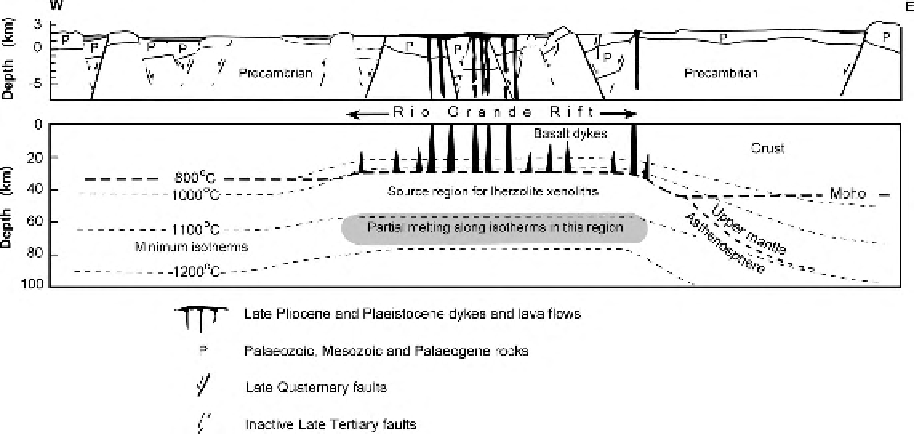Geoscience Reference
In-Depth Information
Figure 10.58.
Cross sections of the (a) geological and (b) thermal structure beneath
the Rio Grande Rift. (From Seager and Morgan (1979).)
by thinning of the lithosphere beneath the rift, and the small positive anomaly
beneath the rift is caused by shallow, dense intrusions at the rift itself.
Heat flow along the rift is high, about 120-130 mW m
−
2
, with local values of up
to 400 mW m
−
2
. Results from studies of xenoliths (fragments of rock brought up
from depth) erupted from volcanoes indicate that their source is at a temperature
greater than 1000
◦
C. Figure 10.58 illustrates the temperature field beneath the rift.
The uppermost mantle is also the location of significant electrical-conductivity
anomalies, with high conductivity (low resistivity) beneath the rift. This is yet
another piece of evidence that the temperatures in uppermost mantle beneath the
rift are very high.
Since detailed instrumental studies began in 1962, the seismicity in the rift has
not been high by western American standards; on average there have been only two
earthquakes per year with magnitude greater than 2. Several areas of concentrated
microseismic activity exist in the rift and are associated with magma bodies in
the middle and upper crust. An aseismic region has particularly high heat-flow
values (up to 200 mW m
−
2
), indicating that the lack of seismic activity is due to
high temperatures in the crust. Fault-plane solutions for the microearthquakes in
the rift show that the focal mechanisms are predominantly normal faulting with
some strike-slip faulting.
The microearthquake data have also been used to delineate the top of the
mid-crustal magma body beneath the rift. The seismograms for earthquakes in
the region of Socorro, New Mexico, U.S.A., show pronounced secondary energy
arriving after the direct P- and S-waves (Fig. 10.59). These arrivals, S
z
P and S
z
S,

